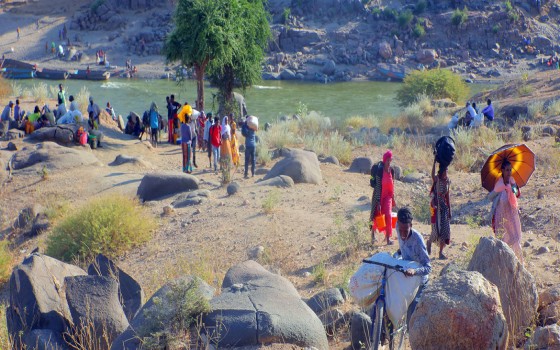
Plastic is destroying our planet ... Prepared by Dr. Abdel Moneim Sedky, Professor at the Research Center - Egypt

- Europe and Arabs
- Saturday , 3 June 2023 11:53 AM GMT
Plastic prepared by Dr. Abdel Moneim Sedky, Professor at the Research Center
On the occasion of World Environment Day on June 5, which was inaugurated in 1972 as a global event, it should be a platform for public awareness to preserve the environment with an invitation to the world to work together to face the greatest environmental challenge of our time and to raise global awareness towards reducing the burden of plastic pollution on human health and confront what It poses a threat to the environment and the life of organisms. Alexander Parks, the first inventor of plastic in 1855 - who was considered a revolution in the world of industry at the time - did not imagine that it would be the cause of the destruction of the planet and a major contributor to its pollution.
The total plastic produced since its inception amounted to about 11 billion tons, and only 10% of it was recycled, and the rest was either buried, at the bottom of the seas and oceans, or on land. The decomposition of one bottle of plastic takes a period of time that may reach 400 years, because the decomposition of plastic takes place under non-biological decomposition processes that take a long time. The huge amount of plastic waste is a product of modern life, in which plastic is used in single-use products, such as drinking bottles, of which the world consumes 2 million bottles every minute, and Coca-Cola produced 110 billion of those bottles. The negative ecological effects and health damage caused by it cannot be ignored. The world is in dire need to reduce plastic production and overuse, as it remains present in the environment for a long time, as it does not biodegrade but breaks into nanoscale parts and ends up with at least 8 million tons of plastic annually in the oceans, which is equivalent to a truck full of waste every minute. .
microplastic particles
Microplastics are all plastic particles with a size of less than 5 mm. They arise in the marine environment as a result of the decomposition of large plastic waste as a result of erosion factors such as the movement of wind and waves and the effect of ultraviolet rays, or they penetrate into the marine environment directly from the primary sources of sewage and drainage openings, as they are used in medical preparations and cosmetics. cosmetics, washing powders, paint and more. There are microplastic granules, such as clothing fibers, and some plastic waste is decomposed by light due to the presence of ultraviolet rays in the sunlight that reaches the earth. The ultraviolet rays provide the energy needed for oxygen atoms and merge with the plastic polymer, which leads to its weakening and makes it fragile and transforms into small nano-sized pieces.
Microplastic particles can be micro and nano-size to a degree that cannot be detected due to the difficulty of monitoring them with the available analyzes. Also, the detection of nanoplastics is still limited because its concentration is low and the size of its particles is small. A study conducted by the Australian University of Newcastle in 2019 showed that plastic is transmitted from the environment to food at a rate of 5 grams By consuming bottled water, fish, and salt, nanoplastic particles may penetrate cells and alter the gut microbiome, which may have effects on the endocrine system, the immune system, and the nervous system. And in 2018, some research at Kings College University indicated that microplastics could pass from the airway or intestines into the blood and into the various organs of the body, causing health problems.
Plastic damage to humans
Many negative effects of plastic products that threaten human health have been discovered, especially the materials used in the manufacture of food containers. When exposed to a high temperature, such as heating them in a microwave, these chemicals can leak into food and transmit it to humans. There are also many harmful chemicals that are used in the manufacture of plastic packaging and bags on human health, including the risk of developing some cancers and increasing insulin resistance, which is related to diabetes and increasing the percentage of fat storage in the body.
Some studies have shown that plastic in the intestines can affect the immune response of the digestive system or help transport chemicals and pathogens, which has implications for patients with diseases of the digestive system.
Twelve plastic fragments were found in four donated placentas after birth. These pieces were made of polypropylene, while the other pieces appeared to be plastic particles from coatings, paints, adhesives, and cosmetics.
The Royal Society issued a report in 2019 that explained the impact of microplastics on the human gastrointestinal tract, as it can disrupt the microbiome, cause damage to intestinal cells, and may increase the risk of cancer. It explained the possibility of bisphenol A, which is found in the plastic linings of tin cans, interacting with hormones and has been linked to several diseases, including Decreased fertility, problems with brain and bone development, and cancer. There are concerns that microplastics may carry other toxic chemicals into the body because, in water, they act as a magnet for pesticides and other toxic substances and become coated with them.
The effects of plastic waste on the marine environment
Fish and marine organisms swallow small pieces of plastic and accumulate in their stomachs. Plastic pieces were discovered in fish, shrimp, mussels, oysters, and even seabirds. Thousands of marine animals died as a result of eating plastic. One study showed that fish in the North Pacific swallow about 12-24 thousand tons of plastic annually. In another study, it was found that 25% of fish in California markets contain plastic in their digestive system, and 50% of sea turtles worldwide ingested plastic and were affected by it. About 60% of all seabird species have ingested plastic, and by 2050 that percentage will rise to 99%. Most of the plastic waste is not biodegradable and has the ability to persist and you may ingest it
The large ones cause suffocation and death, and the neglect of some fishing nets that are left in the sea are exposed to birds and spend in them, or they impede the movement of marine organisms and fish, which causes their death. Plastic damage to mammals
Marine mammals swallow plastic and get entangled in it, and whales and dolphins of more than one kind and others have been found. In a study that took eight years, it indicated that about 388 seals were stuck in the remains of plastic bags in different regions. Whales feed by suction, so they withdraw a large amount of ocean water and extract nutrients from it. The problem occurs when the whale withdraws the amount of water that contains plastic waste and cannot get rid of it in a natural way.
The impact of plastic waste on greenhouse gases
Burning plastic waste to get rid of it contributes to the emission of greenhouse gases to the atmosphere, as the process of burning plastic bags pollutes the air with toxic gases and fumes that are harmful to human health, such as formaldehyde CH2O, benzaldehyde C6H5CHO, hydrogen cyanide HCN, ammonia NH3, carbon monoxide CO and nitrogen oxides NO2 -N2O - N2O3 - N2O4 And some volatile hydrocarbons (VOCs) and others. These substances cause various disorders and diseases such as allergies, respiratory diseases, nervous system, digestive system, heart, liver, kidney and other diseases. In parallel, plankton sequester 30-50% of carbon dioxide emissions from human activities, but after they absorb microplastics, the ability of plankton to remove carbon dioxide from the atmosphere decreases.
Measures to reduce plastic production
For the safety of the planet, it is necessary to immediately reduce plastic production and consumption and switch to safe alternatives across the entire value chain. As the effects of plastic waste that is poorly managed.
• Reducing the use of plastic products in the circulation and packaging of foodstuffs, which leads to a decrease in the demand for polyethylene and polypropylene.
• Implementing awareness programs to reduce the use of plastic bags with large-scale educational projects. To enhance awareness through awareness campaigns in various media not to throw waste into the sea by fishermen and sea-goers and urge them to collect waste and dispose of it after their arrival on land.
Imposing a plas tax on the bags, where the consumer pays a tax for each bag used and transferring the tax money to a special fund for the effects of pollution in the bags
• Soft plastic bags that are used in commercial markets must be recycled according to standards that ensure the reduction of their emissions
• Following a waste prevention strategy represented in reducing the proportion of plastic waste by sorting at the source
• Promote alternative products such as bamboo products, wood products, paper products, and plastic products that are biodegradable by oxidation, and the need to use alternatives to environmentally friendly plastics, regardless of their cost and weight, and avoid the use of single-use plastics such as drinking straws
• Prevent the use of shopping bags less than 0.025 mm thick made of high-density polyethylene
• Punishment of violators of laws and regulations related to the protection of land and sea
• Conducting studies to find out the impact of solid waste on ecosystems and marine wildlife.
• Carrying out campaigns to clean the seabed from heavy and large solid waste. Several governorates in Egypt and many NGOs have launched campaigns to clean beaches from plastic waste. Perhaps the most famous of these is the imposition of a ban on the use of plastic in the Red Sea Governorate
• Establishment of artificial marine buoys in the areas of diving and fishing so as not to break the coral reefs because of the anchors of boats and ships.
The world has become threatened by the effects of plastic waste, and everyone must work together for the safety of the planet by following a targeted and innovative circular economy approach, as it begins at the stage of product design and selection of raw materials with the aim of developing products optimized for reuse, creating “renewable resources” and reducing the need for final disposal of waste and mining virgin material












No Comments Found